[New search]
[Help]
Electronic delivery in law: what difference does it make to results?
Stephen Migdal
Principal Lecturer in Law, University of The West of England
<[email protected]>
Martin Cartwright
Principal Lecturer in Law, University of Wolverhampton
<[email protected]>
Copyright © 2000 Stephen Migdal and Martin Cartwright.
First Published in Web Journal of Current Legal Issues in association with
Blackstone Press Ltd.
This article details research which attempts to assess what effect electronic
delivery of law modules has on actual student assessment performance. The
authors reviewed the assessment results of students who had taken both
conventionally and electronically delivered modules and compared and contrasted
individual student performances in all the modules studied by them in a
particular semester. As far as the authors' researches were able to ascertain
this was a relatively unique piece of research as far as legal study is
concerned. We found that weaker students (those who might ordinarily fail
or scrape a bare pass) were achieving a mark some 10% higher than that achieved
in the conventionally delivered modules; pushing those students into the
lower second category - the assessment criteria for such classification demanding
evidence of deep as opposed to surface learning. However there was little
or no difference in the marks achieved by upper second quality students.
The authors acknowledge that many factors affect the quality of assessment
performance and that, whilst the article addresses some of the variables,
any specific conclusions based on results alone are open to question.
Furthermore, we accept the limitations of a small and narrow statistical
sample and that therefore this can only be a survey rather than a controlled
experiment. Nevertheless we believe that as part of the debate on the role
of C & IT it has a useful role to play.
Inevitably an article such as this trespasses on many pedagogical issues
deserving debate which goes beyond the objectives of this discussion.
Key Words
Electronic delivery; effect on results, value in promoting deeper learning,
improved performance of weaker students; the importance of some degree of
face to face tuition.
Bibliography
Over the past two years the authors have undertaken a number of empirical
studies assessing the pedagogic advantages and disadvantages of delivering
modules electronically via CD Rom, the internet and floppy disk (see: Migdal
and Cartwright (1997) and (1998)). Our particular conclusion was that, at
the very least, electronic delivery is a more than adequate substitute for
the surface knowledge type lecture and should so be used to free up reflective
study time for both student and tutor. But can it do more than this?
Can C & IT facilitate deeper learning and understanding? We believed
so although it is important to emphasise at the outset that an affirmative
answer to this question would do nothing to detract us from our firmly held
subscription to the view that it could never replace face to face contact
completely (see our conclusions).
Our conclusions as to deep learning capabilities of C & IT learning were,
however, based on somewhat qualitative subjective criteria; namely the
evaluations of staff and students. (For similar qualitative research findings
see: Widdison and Schulte R (1998), Widdison and Pritchard (1995).) We wondered
whether quantitative evidence in support might be found by comparing individual
student assessment performance across conventionally and electronically delivered
modules. In short, does electronic delivery produce more effective learning
i.e. better results?
Of course we were very wary of making assumptions that there was some, or
any, correlation between assessment grades and the subject delivery method.
However, as we now explain, we felt sufficiently able to divorce some of
the major variables so as to justify proceeding with the research. Tutor
motivation engendering student enthusiasm must be major contributors to student
success. And tutor commitment to electronic delivery might consciously or
sub-consciously lead to "generous" marking (the self-fulfilling prophecy
argument). However we deliberately chose to examine results that pre-dated
the decision to undertake the research. Accordingly, when delivering and
marking their courses, tutors were unaffected by knowledge of the research.
Furthermore, and most significantly, when delivery methods moved from
conventional to electronic the external examiners responsible for approving
grades remained the same. It is a safe assumption that they remained objective
when confirming improved grades.
But what of the other side of the coin: student demotivation arising from
the boredom of expository lectures as graphically stated by Gibbs (1995 at
p.2)
"traditional teacher centred methods and syllabus centred methods have not
always led to quality in learning but to passive, bored students giving back
to teachers what they have been given in a worthless grade-grubbing way
irrelevant to their future lives".
Would any differential in results reflect rather more the shortcomings of
more conventional delivery than the advantages of electronic delivery? Research
shows (Gibbs 1992 at p.4) that
"a surface approach does tend to produce marginally higher scores on tests
of factual recall immediately after studying".
The issue therefore is not the results themselves but what they represent
in terms of understanding and appreciation. The assessment criteria reproduced
below (in appendix II )show that a grading above
a third demands evidence of deeper learning. We acknowledge that an assessment
grading does not necessarily equate with the reality of the student's depth
of learning. Furthermore we recognise that the type of assessment may well
impact upon the quality of result. (See, generally, Brown and Knight (1995).)
Although there is some published comparative research in other disciplines
we found a paucity of it in law. We suspect that this deficiency is only
partly due to a concern as to what results might actually prove. Primarily
we believe it is due to the inability to compare "like with like". The School
of Legal Studies at the University of Wolverhampton, as far as we can ascertain,
was and is in a fairly unique position as regards the number and spread of
electronically delivered modules being offered together. We were not compelled
to compare students in different years of study, of different sexes, of different
ages and with different social pressures on their studies. We were able to
compare the same student's performance in conventional and electronically
delivered modules thereby removing numerous other obvious variables that
might affect performance.
We conducted research into the results of students at Wolverhampton University
during the academic year 1997/98; comparing and contrasting assessment
performance in electronically and conventionally delivered modules undertaken
by the same student during the same academic year. We looked at student
performance in 7 modules. The largest module had 74 registered students and
the smallest had 13 (see Graph 1 - Figure 1 below). In all we looked at 295
student performances. This was a small and narrow sample (students from one
institution only) and we were aware of the dangers of arriving at definitive
conclusions based on such a sample. We also accept that this was, in essence,
a survey rather than a controlled experiment (The authors have
now embarked on a full-scale controlled experiment; the results of which
will be published in 2001). We were mindful of Richardson's "health warning"
(1994) against drawing any valuable conclusions on teaching and learning
from empirical research. We were seeking to investigate the impact of C &
IT by examining both the results of individual students undertaking the modules
in our investigation and the overall module results. However, we are firmly
of the view that the differences in student performance between the modules
could not be explained by natural variation alone and that differences in
student performance may be the consequence of the use of C & IT.
At the very least our findings point towards the need for further research
in this area.
Top | Contents |
Bibliography
(1) Modules using C & IT as a central part of the delivery method may
result in better assessment performances than those delivered conventionally
i.e. without any electronic component.
(2) Accepting, however, that the key to effective learning is the student
centred nature of the delivery method rather than the method itself C &
IT student centred modules produce a better assessment performance whatever
the teaching and learning approach. Accordingly surface knowledge-giving
expository lectures can and should be abolished. Here we are using "student
centred" according to the Gibbs' definition (1995 at p.1.) namely where
"the emphasis is on:
-
learner activity rather than passivity, and what the student does in order
to learn rather than on what the lecturer does in order to teach;
-
students' experience on the course, outside the university and prior to the
course rather than on knowledge alone;
-
process and competence, on how students do things, rather than just on content
and what they know;
-
and, most importantly, where the key decisions about learning are made by
the student or by the student through negotiation with the teacher rather
than solely by the teacher. These decisions include:
-
what is to be learnt (the goals);
-
how and when it is to be learnt (the methods and schedule);
-
with what outcome (the assessment product or evidence);
-
what criteria and standards are used to assess the outcome;
-
what judgments are made (the marks or grades);
-
by whom these judgments are made."
(3) The assessment criteria governing the study demanded that higher marks
(lower second and above) cannot be achieved by those demonstrating only surface
knowledge. Accordingly if the study revealed a lower second or better
than average performance this is some evidence in support of the
proposition that C & IT delivered modules may produce deeper learners.
Top | Contents |
Bibliography
We compared the students' average result in their electronically delivered
module(s) with their average result in their non-electronically delivered
modules. In an attempt to exclude some variables we also compared the average
mark in the C & IT modules with the average mark in Law of Medicine
(100% coursework assessed but not student centred) and with Health &
Safety Law (100% coursework assessed and paper student centred).
The electronic modules considered were:
This module was conventionally taught in the academic years 1995/1996 and
1996/1997. That is by way of two, information giving, lectures per week followed
by a fortnightly seminar. The module was taught over a whole academic year
(30 weeks) and was assessed by way of a three hour unseen examination. The
School of Legal Studies embraced modularity and semesterisation in 1997/98
and a slimmed down version of the module was then taught over a single semester
(14 weeks). The assessment was then based on coursework. There was no
examination. The module was delivered on a "workplan" method whereby students
were given study plans in each of 5 topic areas. The plans contained study
questions as well as study tasks which each student was required to complete
(for a description of the workplan method see Migdal and Cartwright (1991)).
Students were assessed on the basis of their performance in each workplan.
The improvement in student performance indicated by Graph 4 - figure 4 may
be attributable to the change from a year long module to a semester based
one or to the change in assessment strategy. But, it should be noted that
the teaching team on this module remained the same and it had the same set
of external examiners. We are of the view that the dramatic improvement in
student performance in 1997/1998 could be accounted for by the change in
delivery method from conventional to electronic. The teaching team on the
module certainly took this view
These two modules are both semester based modules. They are taught on the
using the "workplan" method. Assessment in respect of both modules was by
way of workplan performance and 3,000 word assignment. Poverty Law had 67
students registered on module. Housing Law had 65 students registered.
This is a 2nd/3rd year single semester module. As with
the Poverty and Housing Law modules it is taught using the workplan method
however 100% of the assessment is based on the students' performance on the
workplans. There is no written assignment. 74 students were registered on
the module.
The non-electronic modules were:
This was a single semester module taught traditionally that is, by way of
two weekly lectures and fortnightly seminars. The assessment was, however,
by way of 100% coursework - two 3,000 word written assignments. There were
65 students registered on the module.
A single semester module delivered using a student centred approach. Students
were given workplans and study tasks and paper based study materials. Assessment
was by way of 100% coursework. There were 13 registered students.
The University of Wolverhampton uses an alpha numeric grading scale for all
its undergraduate programmes (see Appendix I). The School of Legal Studies
has established Assessment Criteria in respect of all modules in its portfolio,
a copy of which can be found in Appendi
xII.
FIGURE 1
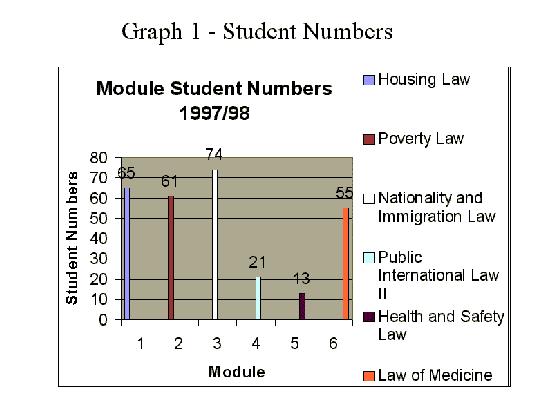
Figure One indicates the number of students that were involved in
our study. The largest module had 74 registered students, the smallest had
13. Altogether the study examined 295 student module performances.
Housing Law, Poverty Law, Nationality and Immigration Law and Public
International Law were all delivered electronically. Two comparator modules
were examined. Law of Medicine was delivered conventionally - two information
giving lectures per week and a fortnightly seminar. Health & Safety used
a paper based student centred delivery method.
FIGURE 2
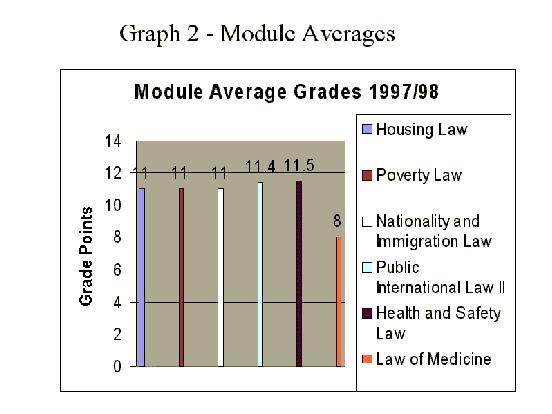
Figure Two shows the average module grade achieved by students on
the modules in the study.
It will be noted that there is little difference between the average grade
in the electronic modules and that achieved in the paper-based student centred
Health & Safety. All achieving an average of 11+ i.e. lower 60's in
percentage terms. However the conventionally delivered Law of Medicine achieves
a much lower average of 8 i.e. 50% in percentage terms and this despite the
fact that this module was assessed by way of 100% coursework, providing some
evidence that it is not the assessment method that determines performance.
FIGURE 3
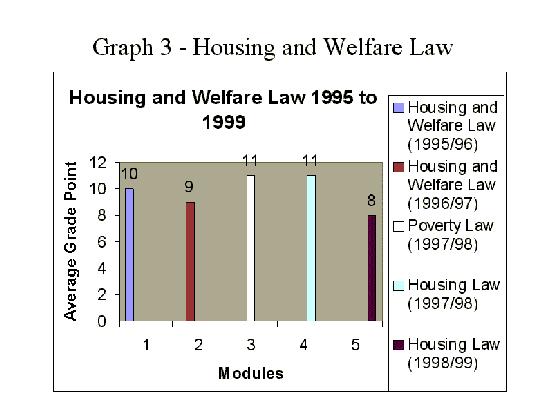
Figure 3 shows the average grades in Housing and Welfare Law, Poverty
Law and Housing Law during the period 1995 to 1999.
Housing and Welfare Law split into two modules (Housing and Poverty) in 1997.
Prior to that it had been a paper based student centred module. It will be
noted that there has been a considerable improvement in the performance of
students on Poverty Law and Housing Law (1997 to 1998) in comparison with
the results in Housing and Welfare Law (1995 to 1997), some evidence, perhaps,
that electronic student centred delivery achieves better results than
its paper-based equivalent. The Housing Law result for 1998/99 appears
disappointing in comparison. However, this result must be seen in the context
of an overall poor result in the semester to which this module contributed.
In fact, when compared with the other modules delivered during this semester,
the Housing Law average is up to two grade points (6%) better than the average
for other modules.
FIGURE 4
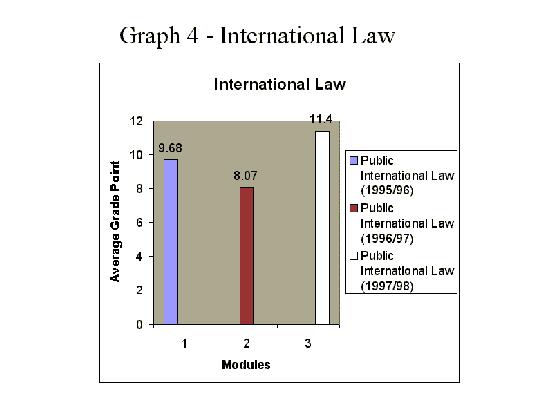
Figure 4 shows the average grades in Public International Law.
This graph illustrates a dramatic improvement in the overall scores of students
accessing this module in 1997/98 compared with the overall grades in previous
years when it was conventionally taught (i.e. information giving lectures
and seminars)
FIGURE 5
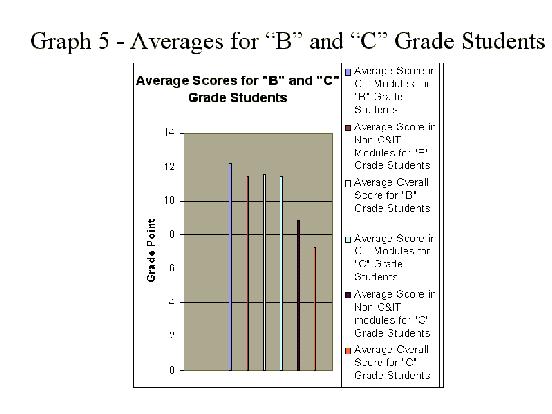
FIGURE 6
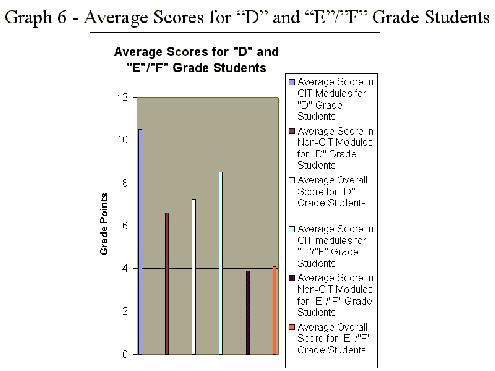
Figures 5 & 6 attempt to illustrate the impact of student performance
of undertaking modules which are delivered using Communications and Information
Technology by showing the average grades of 65 students.
The graph also seeks to show the impact in respect of different student ability
ranges. The overall average in the C&IT modules is greater by some 3
whole grade points (in percentage terms this equates to about 10%) than the
overall average.
The most interesting finding is the different impact of accessing C&IT
modules on students of different ability ranges. It seems that the good student
(i.e. in the upper second category and above) is only marginally affected
by undertaking C&IT modules. The average in these modules being 12.2
against the average in their non C&IT modules of 11.41 i.e. approximately
2%.. However, the further one goes down the ability range the more dramatic
the difference. Thus students whose final overall grading is a fail grade
of 4.2 achieved an average in C&IT modules of 8.5 compared to 3.9 in
non C&IT modules - a difference of 4.6 or approximately 14%.
Top | Contents |
Bibliography
As already stated we have struggled to find other studies in which a comparison
has been made between the results of individual students undertaking
both electronically delivered and non-electronically delivered modules at
the same time. Indeed studies comparing assessment performance generally
are rare but those that have occurred have compared performance as between
electronically delivered courses rather than on an individual student
basis.
Fairhurst (1999) reports both better individual subject and overall performance
from students studying the CPE by way of on-line delivery (ODL).
Average per Subject (ODL and Conventional)
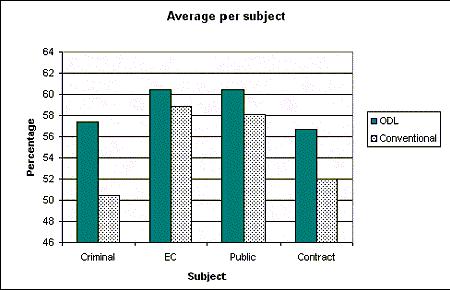
Pass-rate per Subject (ODL and Conventional)
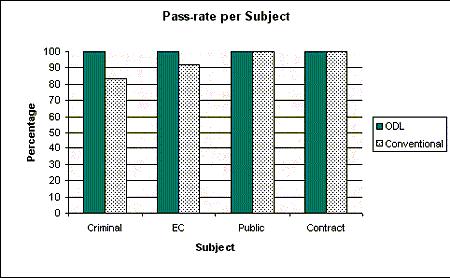
The students studied four modules over one year and there were twelve days
of face to face tuition; otherwise contact was by e-mail. Thirteen students
were on the ODL course (although only 8 completed the assessments at the
end of the year) and fourteen students were on the conventionally delivered
course.
Fairhurst makes the following observations on the better assessment performance
by the ODL students:
" Firstly, the requirement that ODL students regularly submitted tutorial
work should have ensured that they covered the whole syllabus and that any
mistakes or misconceptions were rectified in the tutor's feedback (this was
not a requirement for students on the conventional part-time course). However
there is a caveat to this in that, in practice, six of the eight ODL students
who completed the year soon began to fall behind with tutorial submission
and some of the later tutorials were not submitted.
Secondly, the academic qualifications of the ODL students were generally
higher than those of the conventional part-time students, and therefore the
ODL students might be considered to be academically stronger; this underlying
factor could have had a significant effect on the data.
Nevertheless, a 100% pass rate in the first year of operation is indicative
of the fact that the ODL course was educationally successful."
In 1998 the Sydney College of Law delivered modules to 36 students on its
Legal Practice Programme electronically by distance learning (a pilot run
contemporaneously with its conventional face to face course) and compared
results.
The profile of results of students undertaking the electronic course revealed:
-
a higher percentage of failures (8% compared to 2%)
-
a higher percentage of credits and passes (67% compared to 48%) but
-
a lower percentage of distinctions and high distinctions (25% compared to
52%).
Whilst these first time results are completely contradictory to our findings
(students in all ability ranges fared less well when studying purely
electronically), Mulcahy was recently able to report that:
"Now that the EPP has been delivered several times, assessment results from
EPP students ... [show that] in some modules there do seem to be higher failure
rates among EPP students. However, in other modules the results of EPP students
appear to be better."
Three of the fifteen weeks (20%) of the EPP program were delivered on-campus.
All other tutor contact was limited to e-mail and telephone.
Despite the first year results, both the students and the Directorate of
the Sydney College of Law so preferred the electronic course that it is now
part of its established programme. Students enjoyed the freedom that electronic
delivery gave them and appeared to be prepared to risk sacrificing better
grades for this freedom. The Directorate, whilst recognising the value of
being involved in an innovative educational programme, also saw significant
resource saving benefits. Furthermore (an intrinsic benefit that is often
overlooked) the students involved in the pilot had enhanced IT skills which
were highly valued by their Principals once they entered practice.
Other disciplines are making similar findings as regards the enhanced performance
of weaker students. Coleman (1999) writing in THES of his experiences of
using electronic delivery on the lst year computer engineering course at
Newcastle University observed:
"While it is too early to draw any strong conclusions an analysis of student
performance suggests that the courseware may be better than the original
lecturing in bringing weaker students up to the standard of the others."
Top | Contents |
Bibliography
The most significant and surprising result was that it was the weaker student
whose performance increased most. We say "surprising" because the commonly
expressed view is that the good student does well from student-centred electronic
delivery but the weak student struggles. In our survey the weak student increased
his mark by more than a whole degree classification. Why such improved
performance? The traditional view is that weaker students depend upon the
placebo of the conventional lecture to learn and repeat the law, at best,
sufficiently adequately to merit a bare pass. They do not use the library;
they either do not read textbooks or get little, if anything, from them.
They acquire and repeat surface knowledge only.
Electronic delivery is pushing their performance into the waters of deeper
knowledge. It may be objected that it is not so much improved performance
in the electronic module(s) but decreased performance elsewhere. That because
electronic delivery makes students more responsible for their own learning
the weak student is forced to spend a disproportionate amount of study time
on the electronic module at the expense of the conventionally delivered modules.
What cannot be denied, however, is that the quality of performance
increases.
Of course, for some time now there have been such significant financial and
domestic demands on students, that it is doubtful whether there is such a
thing as a "full-time" student. It may well be, therefore, that the improved
performance of the apparently weaker student is attributable to the accessibility
of teaching and learning materials - attendance at face-to-face lectures
and visits to the library that would otherwise clash with work/domestic demands
are available electronically on demand. This is a matter that we are addressing
in our current research.
Good students do well whatever the delivery method.
We have tried to deal with the argument that modules assessed purely by seen
assignments produce higher grade profiles by reference to the medical law
results. This was taught conventionally but was assessed by way of 100%
coursework. The results, if anything, were worse than in more traditionally
assessed modules.
We accept that student-centred delivery methods, whether electronically or
paper based, (see the good results in Health & Safety Law for example)
do result in improved performance. However the Housing Law graph shows an
increased performance of one grade point and a classification (C10 to B11)
when moving from paper based to electronically delivered student centred
delivery.
Whilst by this research we have attempted to exclude some of the variables
referred to at the beginning of this article, we accept that others remain.
Nevertheless we believe the research has value. What it does show is that
student performance is not worse; in other words traditional information
giving lectures can be dispensed with without any adverse effect on student
performance (save, perhaps, for the strategic learner).
Of course such a conclusion states nothing new. There is a large amount of
longstanding literature about the inadequacies of the learning experience
of those suffering "traditional" lectures (see, for example, Biggs. (1985)
Cohen Stanhope and Conway (1992) Marton and Wenestam (1978)).
Sadly law lecturers in particular have been slow to abandon expository lectures.
It may well be that the imperative to do so will come not from the availability
of C & IT but rather the practicalities of academic life in this climate
of increased student numbers but reduced resources which can only be exacerbated
by government commitment to increased access, lifelong learning and so forth.
A common early error of those jumping upon the C & IT bandwagon (including
your authors) was that electronic delivery might well be a complete substitute
for other forms of learning. This cannot be the case. Snowballing, pyramiding,
buzz groups and so forth are most successful in a face to face context (see,
for example: Alldridge and Mumford (1998) and Jones and Scully (1998)).
Furthermore the value of the social interaction arising from what we term
"the campus experience" has to be emphasised.
We do not include video and audio conferencing in our definition of face
to face contact. Burge and Howard (1990) found that such inhibited interaction
(see also: Boyd (1999)).
The Wolverhampton courses averaged 17% of face to face contact and those
of the Sydney College of Law's 20%. The Huddersfield project does not specify
its twelve days as a percentage but Fairhurst concluded that the face to
face tuition:
" proved to be a vital element in the learning experience of students, providing
the opportunity for tutors to motivate the students and for the students
to engage in face to face interaction with their fellow students and tutors."
This clear link between social interaction and deep learning has been recognised
for some time. See, for example, Entwhistle and Ramsden (1983) and Garrison
(1992). Indeed our own research revealed that one of the commonest student
complaints about pure electronic delivery is the feeling of isolation (see:
Migdal and Cartwright (1998)).
The importance of the campus experience is clearly shared by the American
Bar Association which refuses to recognise any distance learning programme
unless it contains a minimum of 20% of on-campus delivery (see: the memorandum
to the Deans of ABA Approved Law Schools). This is important and perhaps
comforting in the face of the threat to traditional providers of legal education
from the virtual global providers. Whilst our professional bodies must eventually
recognise, as qualifying law degrees, some electronically delivered programmes
we are convinced that, as in the USA, a significant on-campus component will
be required.
i. "The Alpha Numeric Grading System "
| A14 - A16 |
= |
first |
| B11 - B13 |
= |
upper second |
| C 8 - C10 |
= |
lower second |
| D 5 - D 7 |
= |
third |
| E 3 - E 4 |
= |
fail |
| F 1 - F 2 |
= |
fail |
Each grade point broadly approximates to 3%
iii. "Electronic delivery"
1 x 1 hour whole group overview presentation plus 1 x 30 minute small group
(5/6) workshop in every nine hours of study
Accordingly face to face contact was less than 17% of designated (i.e
timetabled) study time.
All other delivery is via HTML floppy disks containing study programmes with
hypertext links to study materials.
Upper Second Class work demonstrates work of a very good standard. Again
it will reflect the achievement of all of the outcomes specified in respect
of coursework for this module. In essence, a B grade is awarded for doing
the same sorts of things as for a First, but not doing them quite as well;
or for doing many of the things which warrant an A grade but not doing them
all. Written communication skills, analysis of cases and issues and the use
of a wide range of sources are all very important in obtaining an Upper Second
Class mark.
Presentation will be to a high standard, with very few grammatical, punctuation,
typographical or spelling errors. There will be proper footnoting and citations.
The structure of the argument must be completely clear and logical.
Identification and examination of the key issues is essential.
Lower Second Class work is work of a good average standard. All of the attributes
required to achieve the module's specified outcomes for coursework will be
evident. In addition, presentation will be good or very good, but there will
be occasional lapses in grammar, punctuation and spelling. Footnoting and
proper citations are required, as is a bibliography of all sources used in
the argument. Written style will tend to be more narrative than analytical,
though cases/judgements and materials relied upon still will be subjected
to some comment. The structure of the argument will be clear. The main issues
will be clearly identified, but may not be as thoroughly explained and analysed
as they need to be. Some subsidiary issues may be missed. The range of sources
drawn on and incorporated into the argument will not be as wide as for an
Upper Second Class grade.
Third Class work is work of a satisfactory standard, including work which
is a bare pass only. Evidence of the achievement of the module's specified
outcomes for coursework will be found. Presentation will be acceptable but
there may be a number of grammatical and other errors. Not all key issues
will have been identified and explained, though a majority of the issues
will be. There will be a bibliography, but footnoting may be minimal and
citations may not be given in full. The range of sources used is generally
not very wide. There is some analysis of relevant authority, but the style
tends to the narrative. Legal principles will be correctly stated.
Top | Contents
Alldridge P and Mumford A "Gazing into the future through a VDU: Communications,
Information Technology and Law Teaching" (1998) Journal of Law & Society
25 (1) 116
Biggs J.B. (1985) "The role of metalearning in study process British Journal
of Educational Psychology" Vol 55 pp185-212
Boyd W "But what is it good for? Using interactive video in legal education
and practice" (1999) (3) JILT:
<http://www.law.warwick.ac.uk/jilt/99-3/boyd.html>).
Brown S and Knight P "Assessing Learners in Higher Education": Chapter 3:
Kogan Page (1995))
Burge P and Howard R "Audio-conferencing in graduate education - a case study
American Journal of Distance Education (1990) Vol 4 issue 2 pp3-13.
Cohen G, Stanhope N and Conway M "How long does education last? (1992) The
Psychologist Vol 5 No 2
Coleman N: "A Microchip off the old block" Times Higher Education Supplement
12th. March 1999
Entwhistle N and Ramsden P (1983) Understanding Student Learning, London.
Croom Helm
Fairhurst J "Evaluation of an Internet-based PgDL (CPE) Course" (1999) JILT
Vol 3
<http://www.law.warwick.ac.uk/jilt/99-3/fairhurst.html>
Garrison D.R. (1992) Critical Thinking and Self Directed Learning in Adult
Education: an analysis of responsibility and control issues Adult Education
Quarterly Vol 42 Issue 3 pp136-148.
Gibbs G "Assessing Student Centred Courses" Oxford Centre for Staff Development
(1995)
Gibbs G "Improving the Quality of Student Learning" Technical and Educational
Services Limited (1992)
Jones R and Scully J "Hypertext within Legal Education" (1998) Vol. 2 Journal
of Information law and Technology
<http://elj.warwick.ac.uk/jilt/cal/2
jones/>
Marton, F and Wenestam CG " Qualitative differences in the understanding
and retention of the main points in some texts based on the principle-example
structure" in Gruneberg, Morris and Styles: Practical Aspects of Memory,
Academic Press (1978)
Memorandum to the Deans of ABA Approved Law Schools at
<http://www.abanet.org/legaled.distance.html>.
Migdal S and Cartwright M "Pure Electronic Delivery of Law Modules - Dream
or Reality?" (1997)
<http://elj.warwick.ac.uk/jilt/cal/97_2migd/#article99.htm>
Migdal S and Cartwright M "Information Technology in the Legal Curriculum
- Reactions and Realities" The Law Teacher (1998) Vol 32 Number 3).
Migdal S and Cartwright M "Student Based Learning - A Polytechnic's Experience"
The Law Teacher (1991) Vol 25 No 2 120
Mulcahy K "The College of Law's Electronic Professional Program": The Second
Annual Learning in Law Initiative Conference, Warwick January 2000
Richardson J : "Using Questionnaires to Evaluate Student Learning: Some Health
Warnings" from "Improving Student Learning": Oxford Centre for Staff Development.
Ed: Graham Gibbs (1994).
Widdison R and Schulte R, 'Quarts into Pint Pots? Electronic Law Tutorials
Revisited', (1998) (1) The Journal of Information, Law and
Technology
<http://elj.warwick.ac.uk/jilt/cal/98_1widd/>
Widdison R and Pritchard F (1995) 'An Experiment with Electronic Law Tutorials'
4(1) Law Technology Journal 6)
BAILII:
Copyright Policy |
Disclaimers |
Privacy Policy |
Feedback |
Donate to BAILII
URL: http://www.bailii.org/uk/other/journals/WebJCLI/2000/issue4/migdal4.html










